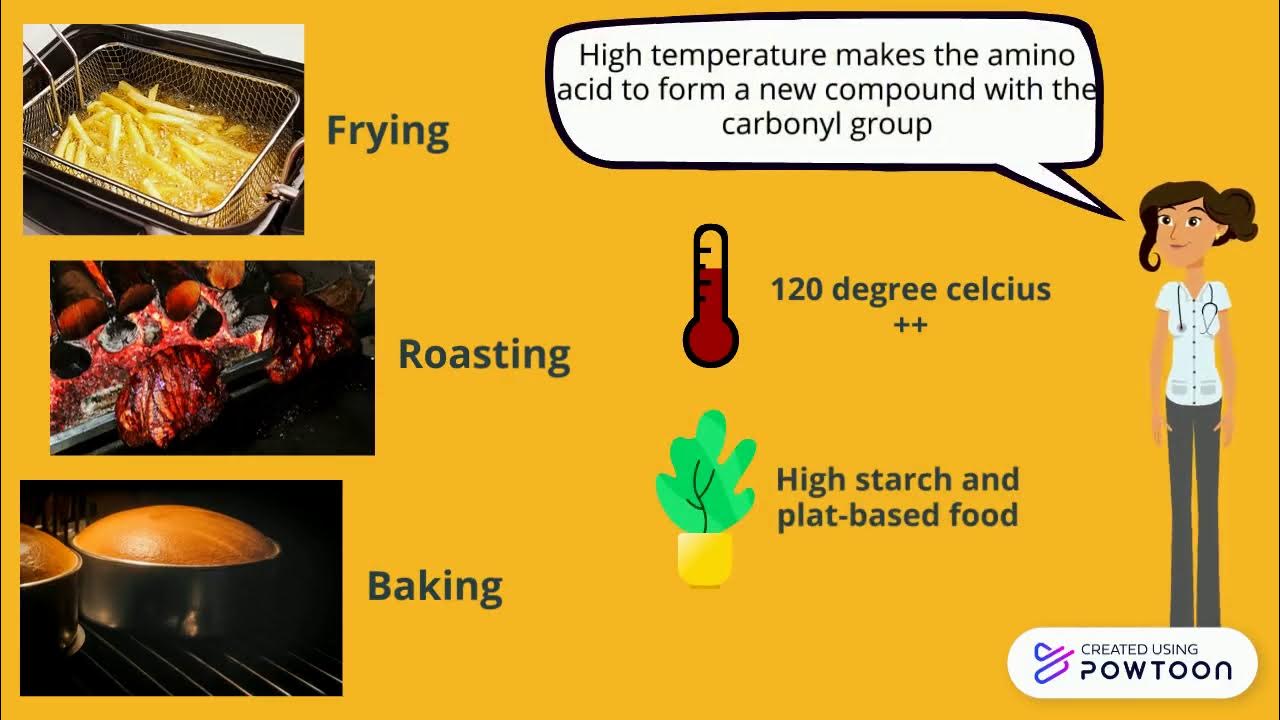Acrylamide
Summary
TLDRAcrylamide, a probable carcinogen, forms in starchy foods like potatoes and bread when cooked at high temperatures. It's linked to DNA damage and has health concerns. To minimize exposure, cook food to a golden yellow, follow package instructions, maintain a varied diet, and avoid refrigerating potatoes to prevent 'cold sweetening'. The FSA encourages industry to reduce acrylamide levels and raises consumer awareness for healthier cooking practices.
Takeaways
- 🔥 Acrylamide is a probable carcinogen that forms when starchy foods are cooked at high temperatures.
- 🥔 Starchy foods like potatoes and root vegetables are prone to acrylamide formation when heated above 120 degrees Celsius.
- 🧬 Laboratory studies show acrylamide can cause cancer in rats and mice, suggesting a potential risk to humans due to its DNA interaction.
- 🚫 Current dietary acrylamide levels are higher than what is considered safe, prompting health concerns.
- 🛑 The Food Standards Agency (FSA) is encouraging the food industry to reduce acrylamide levels in processed foods.
- 📢 FSA is also raising consumer awareness about steps that can be taken to reduce acrylamide exposure.
- 🍟 Cooking food to a golden yellow color, avoiding browning, can help lower acrylamide levels.
- 📦 Follow cooking and reheating instructions on pre-prepared food packaging to manage acrylamide formation.
- 🥗 A balanced and varied diet can help in managing acrylamide intake.
- 🥶 Avoid storing potatoes in the fridge as 'cold sweetening' increases precursor chemicals for acrylamide formation.
- 📣 FSA will continue to update consumers on developments regarding acrylamide and its management.
Q & A
What is acrylamide and why is it a concern in food preparation?
-Acrylamide is a probable carcinogen that forms naturally when starchy foods are cooked at high temperatures, such as frying, grilling, baking, roasting, or toasting. It is a concern because it has been shown to cause cancer in laboratory animals and can potentially do the same in humans.
Which types of food are most likely to contain acrylamide?
-Starchy foods like potatoes, root vegetables, and bread are most likely to contain acrylamide when cooked at high temperatures.
At what temperature does acrylamide begin to form in food?
-Acrylamide begins to form in food when it is cooked to temperatures above 120 degrees Celsius.
What role does acrylamide play in the cooking process?
-Acrylamide is a by-product of the cooking process that improves the texture and taste of food, but it also poses a health risk due to its potential carcinogenic properties.
What evidence is there that acrylamide could cause cancer in humans?
-While direct evidence in humans is limited, acrylamide is known to interact with DNA and cause cancer in rats and mice in laboratory settings, leading to the conclusion that it could also be carcinogenic to humans.
Why is the FSA encouraging the food industry to reduce acrylamide levels?
-The FSA is encouraging the reduction of acrylamide levels because current levels in the diet are higher than what is considered comfortable, and there is a desire to minimize potential health risks.
What steps can consumers take to reduce their exposure to acrylamide in food?
-Consumers can reduce their exposure by cooking food to a golden yellow color, following cooking instructions on packaging, maintaining a balanced and varied diet, and properly storing potatoes to avoid 'cold sweetening'.
Why should potatoes not be stored in the fridge?
-Storing potatoes in the fridge can lead to a process called 'cold sweetening,' which increases the levels of precursor chemicals that form acrylamide when the potatoes are cooked.
What is the recommended way to store potatoes to minimize acrylamide formation?
-Potatoes should be stored in a cool, dark place, but above 6 degrees Celsius to avoid the 'cold sweetening' process that increases acrylamide precursors.
How can consumers stay informed about developments related to acrylamide?
-Consumers can stay informed by keeping up to date with information provided by organizations like the FSA, which will continue to update and inform about any new findings or recommendations.
What is the significance of a balanced and healthy diet in relation to acrylamide intake?
-A balanced and varied diet can help manage the levels of acrylamide by reducing the frequency and quantity of high-acrylamide food consumption, thus lowering overall exposure.
Outlines

Этот раздел доступен только подписчикам платных тарифов. Пожалуйста, перейдите на платный тариф для доступа.
Перейти на платный тарифMindmap

Этот раздел доступен только подписчикам платных тарифов. Пожалуйста, перейдите на платный тариф для доступа.
Перейти на платный тарифKeywords

Этот раздел доступен только подписчикам платных тарифов. Пожалуйста, перейдите на платный тариф для доступа.
Перейти на платный тарифHighlights

Этот раздел доступен только подписчикам платных тарифов. Пожалуйста, перейдите на платный тариф для доступа.
Перейти на платный тарифTranscripts

Этот раздел доступен только подписчикам платных тарифов. Пожалуйста, перейдите на платный тариф для доступа.
Перейти на платный тарифПосмотреть больше похожих видео
5.0 / 5 (0 votes)






